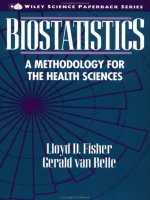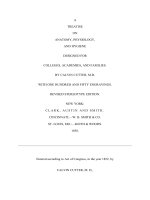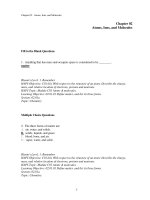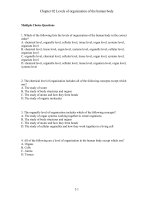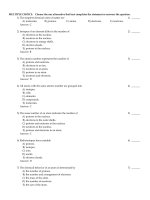Anatomy physiology and disease foundations for the health professions 1st edition roiger test bank
Bạn đang xem bản rút gọn của tài liệu. Xem và tải ngay bản đầy đủ của tài liệu tại đây (307.63 KB, 65 trang )
Chapter 002 Levels of Organization of the Human Body
Multiple Choice Questions
1. Which of the following lists the levels of organization of the human body in the correct
order?
A. chemical level, organelle level, cellular level, tissue level, organ level, systems level,
organism level
B. chemical level, tissue level, organ level, systems level, organelle level, cellular level,
organism level
C. organelle level, chemical level, cellular level, tissue level, organ level, systems level,
organism level
D. chemical level, organelle level, cellular level, tissue level, organism level, organ level,
systems level
2. The organelle level of organization includes which of the following concepts?
A. The study of organ systems working together to create organisms
B. The study of body structures and organs
C. The study of atoms and how they form bonds
D. The study of cellular organelles and how they work together in a living cell
3. All of the following are a level of organization in the human body except which one?
A. Organs
B. Cells
C. Atoms
D. Tissues
4. What is matter?
A. Anything that takes up space
B. Anything that has mass
C. Anything that takes up space and has mass
D. Everything is composed of matter.
2-1
Chapter 002 Levels of Organization of the Human Body
5. All of the following items are composed of matter except which one?
A. All of the answer choices have matter.
B. The air we breathe
C. The steam formed from boiling water
D. The fumes emitted from a vehicle
6. Which forms of an element can be used as a diagnostic tool?
A. Isotopes
B. Radioisotopes
C. Atomic isotopes
D. Radioactive
7. Which of the following is found orbiting the atom?
A. Proton
B. Neutron
C. Electron
D. Nucleus
8. Which of the following correctly describes the atomic number?
A. The combined number of protons and neutrons
B. The number of protons
C. The number of electrons
D. The combined number of protons and electrons
9. Which of the following types of bonding is characterized by two or more atoms sharing
electrons to fill their outer shells?
A. Ionic bond
B. Covalent bond
C. Charged bond
D. Hydrogen bond
2-2
Chapter 002 Levels of Organization of the Human Body
10. All of the following statements describe functions of water except which one?
A. Water chemically bonds molecules to form electrolytes.
B. Water works as a lubricant in tears and the fluid of joints.
C. Water aids in chemical reactions as in saliva during digestion.
D. Water is used to transport nutrients and wastes in blood plasma.
11. Which statement correctly describes a hypertonic solution when compared to another
solution?
A. The solution is more concentrated with solutes than the other solution.
B. The solution has the same concentration of solutes as the other solution.
C. The solution is less concentrated with solutes than the other solution.
D. The solution is less concentrated with solvent than the other solution.
12. What is an acid?
A. A molecule with a pH of 7
B. A molecule that releases hydroxide ions when added to water
C. A molecule that releases hydrogen atoms when added to water
D. A molecule with a pH higher than 7
13. What is a base?
A. A molecule with a pH of 7
B. A molecule that releases hydroxide ions when added to water
C. A molecule that releases hydrogen atoms when added to water
D. A molecule with a pH less than 7
14. If a solution has a pH of 12, which of the following statement is incorrect?
A. The solution is a base.
B. The solution will release hydroxide ions when added to water.
C. The solution is alkaline.
D. The solution will release hydrogen atoms when added to water.
2-3
Chapter 002 Levels of Organization of the Human Body
15. What condition results if the blood's pH is less than 7.35?
A. Acidosis
B. Alkalosis
C. Acidic
D. Alkaline
16. What are the four types of organic molecules?
A. Glucose, proteins, lipids, nucleic acids
B. Carbohydrates, proteins, lipids, nucleic acids
C. Monosaccharides, proteins, lipids, nucleotides
D. D.Carbohydrates, amino acids, lipids, nucleic acids
17. All of the following are examples of the function of proteins except?
A. Transport
B. Strength
C. Fight foreign invaders
D. Store energy
18. Which organic molecules are responsible for composing DNA as the genetic material of
the cell?
A. Proteins
B. Lipids
C. Nucleic Acids
D. Carbohydrates
19. What are the building blocks of proteins?
A. Monosaccharide
B. Amino acid
C. Nucleotide
D. Glycerol
2-4
Chapter 002 Levels of Organization of the Human Body
20. Which of the following is an example of the function of lipids?
A. Genetic material
B. Transport
C. Fight foreign invaders
D. Store energy
21. Carbohydrates contain carbon, hydrogen, and oxygen in which of the following ratios?
A. 1:1:1
B. 2:1:2
C. 1:2:1
D. 2:1:1
22. What is metabolism?
A. The speed of chemical reactions in a human body
B. The sum total of all chemical reactions in the human body
C. The temperature of chemical reactions in the human body
D. The concentration of reactants in chemical reactions within the human body
23. What governs the speed of a reaction?
A. The concentration of reactants
B. The temperature of the reaction
C. The presence of a catalyst
D. All of these are correct.
24. Why does the human body use cellular respiration?
A. To release energy within the bonds of the glucose molecule
B. To create carbon dioxide
C. To produce water
D. To allow us to breathe
2-5
Chapter 002 Levels of Organization of the Human Body
25. What is ATP?
A. A usable form of energy for the cell
B. A modified glucose molecule
C. The waste product produced by cellular respiration
D. Adenosine diphosphate
26. Which organelle regulates what enters and exits the cell?
A. Cell membrane
B. Golgi complex
C. Lysosomes
D. Nucleus
27. Which organelle is responsible for assembling amino acids into proteins?
A. Cell membrane
B. Golgi complex
C. Lysosomes
D. Ribosomes
28. Which organelle is responsible for carrying out cellular respiration?
A. Cell membrane
B. Golgi complex
C. C.Mitochondria
D. Ribosomes
29. All of the following organelles play a part in synthesizing and processing proteins except
which one?
A. Mitochondria
B. Golgi complex
C. Endoplasmic reticulum
D. Ribosomes
2-6
Chapter 002 Levels of Organization of the Human Body
30. The cell membrane performs all of the following functions except which one?
A. Gives the cell structure
B. Regulates what enters and exits the cell
C. Defines the cell's intracellular and extracellular environment
D. Houses DNA
31. The phospholipids in the cell membrane are composed of what?
A. Transport proteins
B. Hydrophilic tails
C. Hydrophobic heads
D. Hydrophobic chains and hydrophilic heads
32. The cell membrane contains all of the following except:
A. phospholipid.
B. secretory vesicle.
C. cholesterol.
D. channels.
33. Which of the following correctly describes passive transport?
A. Transport of materials across the cell membrane
B. Transport of materials across the cell membrane up the concentration gradient
C. Transport of materials across the cell membrane with the use of energy
D. Transport of materials across the cell membrane without the use of energy
2-7
Chapter 002 Levels of Organization of the Human Body
34. Which statement correctly compares passive and active transport?
A. Passive transport move materials across the cell membrane without the use of energy while
active transport move materials across the cell membrane against the concentration gradient
with the use of energy.
B. Passive transport move materials across the cell membrane with the use of energy while
active transport move materials across the cell membrane against the concentration gradient
without the use of energy.
C. Passive transport move materials across the cell membrane with the use of energy while
active transport move materials across the cell membrane against the concentration gradient
with the use of energy.
D. Passive transport move materials across the cell membrane without the use of energy while
active transport move materials across the cell membrane against the concentration gradient
without the use of energy.
35. Which of the following types of transport require energy?
A. Filtration
B. Facilitated diffusion
C. Active
D. Osmosis
36. All of the following are types of passive transport except which one?
A. Filtration
B. Endocytosis
C. Osmosis
D. Simple diffusion
37. What is osmosis?
A. Diffusion across a semi-permeable membrane until concentrations are equal on either side
of the membrane
B. Diffusion across a semi-permeable membrane against the concentration gradient
C. Diffusion across a semi-permeable membrane from areas of low concentration to high
concentration
D. Diffusion across a semi-permeable membrane
2-8
Chapter 002 Levels of Organization of the Human Body
38. Which statement incorrectly describes active transport?
A. Transport of materials from areas of low concentration to areas of high concentration
B. Movement of materials up the concentration gradient
C. Transport of materials across the cell membrane with the use of energy
D. Transport of materials from areas of high concentration to areas of low concentration
39. The sodium/potassium pump is an example of what type of transport?
A. Filtration
B. Facilitated diffusion
C. Active
D. Osmosis
40. Which statement correctly describes endocytosis?
A. The movement of materials in bulk out of the cell
B. The movement of materials in bulk into the cell
C. The passive movement of materials out of the cell
D. The movement of small molecules out of the cell
41. Protein synthesis involves which two stages?
A. Active and passive transport
B. Endocytosis and exocytosis
C. Osmosis and diffusion
D. Transcription and translation
42. ACGUUGCACGU represents what kind of strand?
A. DNA
B. mRNA
C. rRNA
D. tRNA
2-9
Chapter 002 Levels of Organization of the Human Body
43. Which of the following stages of protein synthesis reads the mRNA strand and assembles
a protein based on the sequence of codons present on the mRNA strand?
A. Transcription
B. Translation
C. Ribosomes
D. Transfer
44. Which statement best describes meiosis?
A. Meiosis is a type of cell division that involves all cell types in the human body.
B. Meiosis is a type of cell division that involves sperm and egg cells.
C. Meiosis is a type of cell division that involves all cell types except sperm and egg cells.
D. Meiosis is a type of cell division.
45. Which of the following statements best describes mitosis?
A. Mitosis is a type of cell division that involves all cell types in the human body.
B. Mitosis is a type of cell division that involves sperm and egg cells.
C. Mitosis is a type of cell division that involves all cell types except sperm and egg cells.
D. Mitosis is a type of cell division.
46. Which of the following statements correctly describes the parent cell and daughter cells in
mitosis?
A. In mitosis, the parent cell divides to become two identical daughter cells.
B. In mitosis, the parent cell divides to become two different daughter cells.
C. In mitosis, the parent cell divides to become one identical daughter cell.
D. In mitosis, the parent cell divides to become two identical sex cells.
2-10
Chapter 002 Levels of Organization of the Human Body
47. Which statement correctly compares chromatin to chromosomes?
A. Chromatin is loosely arranged DNA in the cell's nucleus while the cell is not dividing
while chromosomes are tight compact bundles of DNA present during cell division.
B. Chromatin is tightly packed DNA in the cell's nucleus while the cell is not dividing while
chromosomes are also tight compact bundles of DNA present during cell division.
C. Chromatin is loosely arranged DNA in the cell's nucleus while the cell is dividing while
chromosomes are tight compact bundles of DNA present while the cell is not dividing.
D. Chromatin is tightly packed DNA in the cell's nucleus while the cell is not dividing while
chromosomes are loosely arranged bundles of DNA present during cell division.
48. What is the total number of chromosomes in the daughter cell after mitosis?
A. 12
B. 23
C. 46
D. 92
49. All of the following statements describe the consequences of mutations in DNA
replication except which one?
A. The mutation can benefit the cell.
B. The mutation can be detrimental to the cell.
C. The mutation will be passed to future daughter cells.
D. There is no mechanism for proofreading DNA replication in order to avoid mutations.
50. What is telomerase?
A. An enzyme present in cancer cells that repairs telomere damage during replication making
the cancer cell immortal
B. An enzyme present in normal cells that repairs telomere damage during replication making
the normal cell immortal
C. An enzyme present in normal cells that repairs telomere damage during replication
D. An enzyme present in cancer cells that repairs telomere damage during replication making
the cancer cell die
2-11
Chapter 002 Levels of Organization of the Human Body
51. Which statement correctly represents the function of telomeres?
A. Telomeres are protective caps on the ends of chromosomes that help stabilize them.
B. Telomeres are protective caps on the ends of chromosomes that help them replicate.
C. Telomeres are protective caps on the ends of chromosomes that the cell age.
D. Telomeres are protective caps on the ends of chromosomes that allow the chromosome to
stick to other chromosomes.
52. What is histology?
A. The study of tissues
B. The study of the human body
C. The study of the history of anatomy
D. The study of physiology
53. All of the following are tissue classifications except which one?
A. Epithelial
B. Muscle
C. Neurons
D. Connective
54. Which of the following statements correctly describes epithelial tissue?
A. Epithelial tissues cover and line all body surfaces including organs, vessels, and ducts.
B. Epithelial tissues allow for movement of the body.
C. Epithelial tissues have fibers in a matrix.
D. Epithelial tissues allow for communication within the body by using electrical and
chemical signals.
55. Which of the following statements correctly describes muscle tissue?
A. Tissue that lines and covers all body surfaces
B. Tissue that allows for communication through chemical and electrical signals
C. Tissue that allows movements through the contraction of cells
D. Tissue that has cells and fibers in a matrix
2-12
Chapter 002 Levels of Organization of the Human Body
56. Which of the following statements correctly describes nervous tissue?
A. Tissue that lines and covers all body surfaces
B. Tissue that allows for communication through chemical and electrical signals
C. Tissue that allows movements through the contraction of cells
D. Tissue that has cells and fibers in a matrix
57. Which of the following is a function of nervous tissue?
A. Movement
B. Communication
C. Structural support
D. Protection
58. Which of the following is a function of connective tissue?
A. Movement
B. Communication
C. Structural support
D. Coverage
59. Which of the following is a function of muscle tissue?
A. Movement
B. Communication
C. Structural support
D. Coverage
60. Which of the following is a function of epithelial tissue?
A. Movement
B. Communication
C. Structural support
D. Coverage
2-13
Chapter 002 Levels of Organization of the Human Body
61. Which of the following is NOT a shape of an epithelial cell?
A. Cuboidal
B. Squamous
C. Columnar
D. Stratified
62. Which of the following is a correct statement about cardiac muscle?
A. Cardiac muscle cells are branched and multinucleated.
B. Cardiac muscle is striated and voluntary.
C. Cardiac muscle is smooth and involuntary.
D. Cardiac muscle is striated and involuntary.
63. Which of the following statements correctly compares skeletal muscle and cardiac
muscle?
A. Skeletal muscle is striated and voluntary, while cardiac muscle is striated and involuntary.
B. Skeletal muscle is smooth and voluntary, while cardiac muscle is striated and involuntary.
C. Skeletal muscle is striated and voluntary, while cardiac muscle is striated and voluntary.
D. Skeletal muscle is striated and involuntary, while cardiac muscle is smooth and
involuntary.
64. Which answer choice is not considered a type of connective tissue?
A. Bone
B. Blood
C. Muscle
D. Cartilage
65. Which term describes a stacked layer of epithelial cells?
A. Simple
B. Stratified
C. Pseudostratified
D. Transitional
2-14
Chapter 002 Levels of Organization of the Human Body
66. The respiratory track is lined with which tissue type?
A. Muscle
B. Connective
C. Epithelial
D. Nervous
67. Which of the following correctly describes transitional epithelial tissue?
A. A single layer of epithelial cells
B. Stacked layers of epithelial cells
C. Epithelial tissue designed to stretch
D. Epithelial tissue appears to be layered
68. Which connective tissue type functions in storing lipids?
A. Blood
B. Bone
C. Adipose
D. Cartilage
69. What type of cartilage is found in the ear?
A. Hyaline cartilage connective tissue
B. Elastic cartilage connective tissue
C. Fibrocartilage connective tissue
D. Fibroelastic cartilage connective tissue
70. What type of cartilage is found in the nose?
A. Hyaline cartilage connective tissue
B. Elastic cartilage connective tissue
C. Fibrocartilage connective tissue
D. Fibroelastic cartilage connective tissue
2-15
Chapter 002 Levels of Organization of the Human Body
71. Which of the following is not one of the three types of cartilage?
A. Hyaline cartilage connective tissue
B. Elastic cartilage connective tissue
C. Fibrocartilage connective tissue
D. Fibroelastic cartilage connective tissue
72. What is the function of neuroglia?
A. Communication
B. Protection and support
C. Movement
D. Coverage
73. Which statement describes hypertrophy?
A. Tissue growth is achieved by an increase in the number of cells.
B. Tissue growth is achieved by an increase in cell size.
C. Tissue growth is achieved by a decrease in the number of cells.
D. Tissue growth is achieved by a decrease in cell size.
74. Which statement describes hyperplasia?
A. Tissue growth is achieved by an increase in the number of cells.
B. Tissue growth is achieved by an increase in cell size.
C. Tissue growth is achieved by a decrease in the number of cells.
D. Tissue growth is achieved by a decrease in cell size.
75. What is neoplasia?
A. Tissue growth is achieved by an increase in the number of cells.
B. Tissue growth is achieved by an increase in cell size.
C. Controlled cell growth.
D. Uncontrolled cell growth.
2-16
Chapter 002 Levels of Organization of the Human Body
76. Which of the following incorrectly describes a benign neoplasm?
A. A neoplasm that remains localized
B. A neoplasm that is encapsulated
C. A neoplasm that does not metastasize
D. A neoplasm in which cells have broken off and traveled to other parts of the body where
they are producing more abnormal cells
77. Which of the following correctly describes a malignant neoplasm?
A. A neoplasm that remains localized
B. A neoplasm that is encapsulated
C. A neoplasm that does not metastasize
D. A neoplasm in which cells have broken off and traveled to other parts of the body where
they are producing more abnormal cells
78. What describes the change of tissue from one type to another?
A. Neoplasia
B. Hyperplasia
C. Metaplasia
D. Cytoplasia
79. Which term refers to shrinkage of tissue due to a decrease in cell size?
A. Atrophy
B. Necrosis
C. Hypertrophy
D. Apoptosis
80. What is programmed cell death?
A. Atrophy
B. Necrosis
C. Hypertrophy
D. Apoptosis
2-17
Chapter 002 Levels of Organization of the Human Body
81. Which answer choice refers to premature tissue death caused by disease, infection, toxins
or trauma?
A. Atrophy
B. Necrosis
C. Hypertrophy
D. Apoptosis
82. Which statement correctly compares necrosis and apoptosis?
A. Necrosis is premature tissue death caused by disease, infection, toxins or trauma, and
apoptosis is programmed cell death.
B. Necrosis is prolonged tissue death caused by disease, infection, toxins or trauma, and
apoptosis is programmed cell death.
C. Necrosis is programmed tissue death caused by disease, infection, toxins or trauma, and
apoptosis is programmed cell death.
D. Necrosis is premature tissue death caused by diseases, infection, toxins or trauma, and
apoptosis is premature cell death.
83. What causes gangrene?
A. Insufficient blood supply
B. The formation of neoplasms
C. The presence of infection
D. Insufficient blood supply that is associated with an infection
84. Infarction is defined as:
A. programmed cell death.
B. premature death of tissue.
C. sudden blood loss.
D. sudden tissue death resulting from the loss of blood supply.
2-18
Chapter 002 Levels of Organization of the Human Body
85. What is the function of apoptosis?
A. Programmed cell death
B. To remove old, worn out cells
C. To remove cells that have fulfilled their function are no longer needed
D. All of these are correct.
86. What organ system is responsible for gas exchange, sense of smell, and creating pressure
gradients necessary to circulate blood and lymph?
A. Cardiovascular system
B. Nervous system
C. Respiratory system
D. Lymphatic system
87. What organ system is responsible for fluid balance, immunity, and lipid absorption, and
defense against disease?
A. Cardiovascular system
B. Nervous system
C. Respiratory system
D. Lymphatic system
88. What organ system is responsible for communication and hormone production?
A. Cardiovascular system
B. Nervous system
C. Endocrine system
D. Lymphatic system
89. What organ system is responsible for movement, stability, control of body openings and
passages, communication and heat production?
A. Cardiovascular system
B. Nervous system
C. C.Endocrine system
D. Muscular system
2-19
Chapter 002 Levels of Organization of the Human Body Key
Multiple Choice Questions
1. (p. 20) Which of the following lists the levels of organization of the human body in the
correct order?
A. chemical level, organelle level, cellular level, tissue level, organ level, systems level,
organism level
B. chemical level, tissue level, organ level, systems level, organelle level, cellular level,
organism level
C. organelle level, chemical level, cellular level, tissue level, organ level, systems level,
organism level
D. chemical level, organelle level, cellular level, tissue level, organism level, organ level,
systems level
The human body is organized using a hierarchy of levels that starts from the simplest to most
complex. Those levels are: chemical level, organelle level, cellular level, tissue level, organ
level, systems level, organism level.
ABHES: 2.b. Identify and apply the knowledge of all body systems, their structure and functions, and their common diseases, symptoms and
etiologies.
Bloom's Taxonomy: Remember
CAAHEP: I.C.1. Describe structural organization of the human body
Learning Outcome: 02-01 List the levels of organization of the human body from simplest to most complex.
Level of Difficulty: 1 Easy
2-20
Chapter 002 Levels of Organization of the Human Body Key
2. (p. 20) The organelle level of organization includes which of the following concepts?
A. The study of organ systems working together to create organisms
B. The study of body structures and organs
C. The study of atoms and how they form bonds
D. The study of cellular organelles and how they work together in a living cell
The organelle level of organization includes many concepts about cellular organelle structure
and function including how they work together to accomplish the actions necessary for a cell
to maintain life.
ABHES: 2.b. Identify and apply the knowledge of all body systems, their structure and functions, and their common diseases, symptoms and
etiologies.
Bloom's Taxonomy: Apply
CAAHEP: I.C.1. Describe structural organization of the human body
Learning Outcome: 02-01 List the levels of organization of the human body from simplest to most complex.
Level of Difficulty: 2 Medium
3. (p. 20) All of the following are a level of organization in the human body except which one?
A. Organs
B. Cells
C. Atoms
D. Tissues
Atoms and how they bond to form molecules is one of the concepts of the chemical level of
organization in the human body.
ABHES: 2.b. Identify and apply the knowledge of all body systems, their structure and functions, and their common diseases, symptoms and
etiologies.
Bloom's Taxonomy: Remember
CAAHEP: I.C.1. Describe structural organization of the human body
Learning Outcome: 02-01 List the levels of organization of the human body from simplest to most complex.
Level of Difficulty: 1 Easy
2-21
Chapter 002 Levels of Organization of the Human Body Key
4. (p. 21) What is matter?
A. Anything that takes up space
B. Anything that has mass
C. Anything that takes up space and has mass
D. Everything is composed of matter.
All solids, liquids and gases are composed of matter. Matter is defined as anything that takes
up space and has mass.
ABHES: 2.b. Identify and apply the knowledge of all body systems, their structure and functions, and their common diseases, symptoms and
etiologies.
Bloom's Taxonomy: Remember
CAAHEP: I.C.1. Describe structural organization of the human body
Learning Outcome: 02-02 Define the terms matter, element, atom, and isotope.
Level of Difficulty: 1 Easy
5. (p. 21) All of the following items are composed of matter except which one?
A. All of the answer choices have matter.
B. The air we breathe
C. The steam formed from boiling water
D. The fumes emitted from a vehicle
All solids, liquids and gases are composed of matter. Matter is defined as anything that takes
up space and has mass.
ABHES: 2.b. Identify and apply the knowledge of all body systems, their structure and functions, and their common diseases, symptoms and
etiologies.
Bloom's Taxonomy: Apply
CAAHEP: I.C.1. Describe structural organization of the human body
Learning Outcome: 02-02 Define the terms matter, element, atom, and isotope.
Level of Difficulty: 2 Medium
2-22
Chapter 002 Levels of Organization of the Human Body Key
6. (p. 23) Which forms of an element can be used as a diagnostic tool?
A. Isotopes
B. Radioisotopes
C. Atomic isotopes
D. Radioactive
Some isotopes are unstable and freely emit particles to get to a more stable form. If they do,
they are called radioisotopes and their decay, called radioactivity, can be very useful in
medicine for diagnosis and treatment.
ABHES: 2.b. Identify and apply the knowledge of all body systems, their structure and functions, and their common diseases, symptoms and
etiologies.
Bloom's Taxonomy: Remember
CAAHEP: I.C.1. Describe structural organization of the human body
Learning Outcome: 02-02 Define the terms matter, element, atom, and isotope.
Level of Difficulty: 1 Easy
7. (p. 21-22) Which of the following is found orbiting the atom?
A. Proton
B. Neutron
C. Electron
D. Nucleus
Electrons orbit the atom, while protons and neutrons are found in the atom's nucleus.
ABHES: 2.b. Identify and apply the knowledge of all body systems, their structure and functions, and their common diseases, symptoms and
etiologies.
Bloom's Taxonomy: Remember
CAAHEP: I.C.1. Describe structural organization of the human body
Learning Outcome: 02-02 Define the terms matter, element, atom, and isotope.
Level of Difficulty: 1 Easy
2-23
Chapter 002 Levels of Organization of the Human Body Key
8. (p. 21) Which of the following correctly describes the atomic number?
A. The combined number of protons and neutrons
B. The number of protons
C. The number of electrons
D. The combined number of protons and electrons
The number of protons for each element is fixed and is indicated by the atomic number. The
atomic mass is the combined number of protons and neutrons.
ABHES: 2.b. Identify and apply the knowledge of all body systems, their structure and functions, and their common diseases, symptoms and
etiologies.
Bloom's Taxonomy: Apply
CAAHEP: I.C.1. Describe structural organization of the human body
Learning Outcome: 02-02 Define the terms matter, element, atom, and isotope.
Level of Difficulty: 2 Medium
9. (p. 23) Which of the following types of bonding is characterized by two or more atoms
sharing electrons to fill their outer shells?
A. Ionic bond
B. Covalent bond
C. Charged bond
D. Hydrogen bond
Covalent bonds are formed when two or more atoms share electrons to fill their outer shells.
Ionic bonds are formed when two or more atoms give up or receive electrons to fill their outer
shells.
ABHES: 2.b. Identify and apply the knowledge of all body systems, their structure and functions, and their common diseases, symptoms and
etiologies.
Bloom's Taxonomy: Remember
CAAHEP: I.C.1. Describe structural organization of the human body
Learning Outcome: 02-03 Define molecule, and describe two methods of bonding that may form molecules.
Level of Difficulty: 1 Easy
2-24
Chapter 002 Levels of Organization of the Human Body Key
10. (p. 25) All of the following statements describe functions of water except which one?
A. Water chemically bonds molecules to form electrolytes.
B. Water works as a lubricant in tears and the fluid of joints.
C. Water aids in chemical reactions as in saliva during digestion.
D. Water is used to transport nutrients and wastes in blood plasma.
Water carries out the following five functions for the body as the main component of many
body fluids: Water chemically separates ionically-bonded molecules to individual ions called
electrolytes; works as a lubricant in tears and the fluid of joints; aids in chemical reactions as
in saliva during digestion; transports nutrients and wastes in blood plasma; and is used for
temperature regulation.
ABHES: 2.b. Identify and apply the knowledge of all body systems, their structure and functions, and their common diseases, symptoms and
etiologies.
Bloom's Taxonomy: Apply
CAAHEP: I.C.1. Describe structural organization of the human body
Learning Outcome: 02-04 Summarize the five functions of water in the human body and give an explanation or example of each.
Level of Difficulty: 2 Medium
11. (p. 25) Which statement correctly describes a hypertonic solution when compared to another
solution?
A. The solution is more concentrated with solutes than the other solution.
B. The solution has the same concentration of solutes as the other solution.
C. The solution is less concentrated with solutes than the other solution.
D. The solution is less concentrated with solvent than the other solution.
If a solution is hypertonic, it is more concentrated with solutes than the other solution.
ABHES: 2.b. Identify and apply the knowledge of all body systems, their structure and functions, and their common diseases, symptoms and
etiologies.
Bloom's Taxonomy: Analyze
CAAHEP: I.C.1. Describe structural organization of the human body
Learning Outcome: 02-05 Compare solutions based on tonicity.
Level of Difficulty: 3 Hard
2-25

